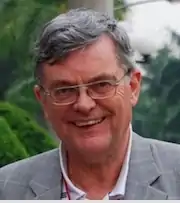T. Maurice Rice | |
|---|---|
 | |
| Born | 26 January 1939 |
| Alma mater |
|
| Awards |
|
| Scientific career | |
| Fields | Theoretical Condensed Matter Physics |
| Institutions |
|
Thomas Maurice Rice (born 26 January 1939 in Dundalk, Ireland), known professionally as Maurice Rice, is an Irish (and naturalised American) theoretical physicist specializing in condensed matter physics.
Life
Rice is the younger brother of structural engineer Peter Rice. He grew up in 52 Castle Road, Dundalk in County Louth with his two siblings. Like his brother, he studied at the local Christian Brothers school, Coláiste Rís. Subsequently he studied physics as an undergraduate at University College Dublin and as a graduate student with Volker Heine at the University of Cambridge. In 1964, he moved to the US and spent two years as a post-doc with Walter Kohn at the University of California, San Diego. Then he joined the technical staff at Bell Labs in 1966, where he stayed until 1981, when he joined the Institute for Theoretical Physics at the Eidgenössische Technische Hochschule (ETH) in Zurich, Switzerland.
Rice and his wife, Helen, moved with their family of a son and two daughters from New Jersey to Zurich. Rice retired from teaching in 2004 and is an Emeritus Professor at ETH.[1][2]
Career
Rice graduated at a time when the field of condensed matter physics expanded from the study of just simple metals and semiconductors to cover a broad range of compound materials. This led him to collaborate with both theorists and experimentalists to analyse the electronic properties of new materials. He joined Bell Labs in the 1960s and 1970s, studying metal-insulator transitions in transition metal oxides, electron-hole liquids in optically pumped semiconductors, and charge and spin density waves.
In the early 1980s, Rice moved to ETH Zurich, a few years before Georg Bednorz and K. Alex Müller at the nearby IBM laboratories made their discovery of high temperature superconductivity in layered cuprate compounds.[3] Rice switched his research to the challenges posed by these novel superconductors. Cuprates became a major topic in condensed matter physics, as a range of properties in addition to high temperature superconductivity were discovered. Rice and collaborators concentrated on developing a consistent microscopic interpretation of the growing experimental results.[4] One challenge was the microscopic description of the mysterious pseudogap phase, which appears in a range of intermediate hole doping; his research group focused on the role of enhanced Umklapp scattering in a nearly half-filled band as key to the unexpected features.[5]
Brinkman-Rice transition
In 1970, Rice and William F. Brinkman helped to characterize the transition from metal to insulator in semiconductors, adding to the Mott-Hubbard approximation. They published a paper addressing the problem of ‘the excitation of two electrons to the outside of the Fermi sea’, in which they modeled approaching the transition from the uncorrelated metallic state, where each orbital is half-filled.[6]
Awards and honours
- D.Sc (h.c.) National University of Ireland (1989)[7]
- Honorary Member, Royal Irish Academy (1988)[8]
- Member, National Academy of Sciences (1993)[9]
- Fellow of The Royal Society (2002)[10]
- EPS Europhysics Prize (1998)[11]
- John Bardeen Prize (2000)[12]
Selected papers
The following papers are Rice's most cited:
- Brinkman, W. F.; Rice, T. M. (15 November 1970). "Application of Gutzwiller's Variational Method to the Metal-Insulator Transition". Physical Review B. 2 (10): 4302–4304. Bibcode:1970PhRvB...2.4302B. doi:10.1103/PhysRevB.2.4302.
- Brinkman, W. F.; Rice, T. M. (15 February 1973). "Electron-Hole Liquids in Semiconductors". Physical Review B. 7 (4): 1508–1523. Bibcode:1973PhRvB...7.1508B. doi:10.1103/PhysRevB.7.1508.
- Zhang, F. C.; Rice, T. M. (1 March 1988). "Effective Hamiltonian for the superconducting Cu oxides". Physical Review B. 37 (7): 3759–3761. Bibcode:1988PhRvB..37.3759Z. doi:10.1103/PhysRevB.37.3759. PMID 9944993.
- Honerkamp, C.; Salmhofer, M.; Furukawa, N.; Rice, T. M. (2 January 2001). "Breakdown of the Landau-Fermi liquid in two dimensions due to umklapp scattering". Physical Review B. 63 (3): 035109. arXiv:cond-mat/9912358. Bibcode:2001PhRvB..63c5109H. doi:10.1103/PhysRevB.63.035109.
- Rice, T M; Yang, Kai-Yu; Zhang, F C (1 January 2012). "A phenomenological theory of the anomalous pseudogap phase in underdoped cuprates". Reports on Progress in Physics. 75 (1): 016502. arXiv:1109.0632. Bibcode:2012RPPh...75a6502R. doi:10.1088/0034-4885/75/1/016502. PMID 22790307. S2CID 15563340.
References
- ↑ Emeritus Professors Department of Physics ETH Zurich
- ↑ Prof. T.M. Rice D PHYS ETH Zurich
- ↑ Switzerland, Address ETH Zürich Dep of Physics Prof em Dr Thomas Maurice Rice Institut für Theoretische Physik HIT K. 43 1 Wolfgang-Pauli-Str 27 8093 Zürich. "Prof. em. Dr. Thomas Maurice Rice | ETH Zurich". www.phys.ethz.ch. Retrieved 27 August 2023.
{{cite web}}: CS1 maint: numeric names: authors list (link) - ↑ "Thomas Rice". royalsociety.org. Retrieved 27 August 2023.
- ↑ Rice, T. M. (1 October 2000). "Breakdown of Landau–Fermi Liquid in Two Dimensions Due to Umklapp Scattering". Journal of Superconductivity. 13 (5): 771–771. doi:10.1023/A:1007830702334. ISSN 1572-9605.
- ↑ Brinkman, W. F.; Rice, T. M. (15 November 1970). "Application of Gutzwiller's Variational Method to the Metal-Insulator Transition". Physical Review B. 2 (10): 4302–4304. doi:10.1103/PhysRevB.2.4302.
- ↑ NUI - Honorary Degrees Awarded
- ↑ Members of Royal Irish Academy
- ↑ "T. Maurice Rice". National Academy of Sciences Member Directory. Retrieved 5 October 2023.
- ↑ Fellows of the Royal Society UK
- ↑ "EPS Europhysics Prize". Retrieved 13 January 2022.
For original contributions to the theory of strongly correlated electron systems.
- ↑ "John Bardeen Prize". M2S 2022 Conference. Retrieved 5 October 2023.
for the physical insight he brought to the understanding of the superconducting state in strongly correlated materials in general, and for the prediction of unconventional pairing in Sr2RuO4 in particular.